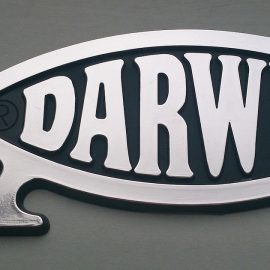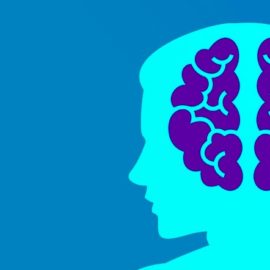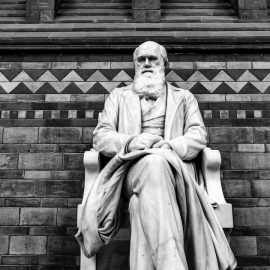

This article is an excerpt from the Shortform book guide to "A Brief History of Time" by Stephen Hawking. Shortform has the world's best summaries and analyses of books you should be reading.
Like this article? Sign up for a free trial here .
What is a quark? How do the particles that are quarks relate to atoms? What role do they play in the universe?
Quarks are subatomic particles that combine by means of a strong force to make up protons and neutrons which in turn make up the nuclei of atoms. In studying quarks, we are looking at the most elemental building blocks of our universe. And it turns out that our knowledge of quarks is the key we can use to unlock a great deal about our universe.
Learn about the discovery of quark particles, their types, properties, and more.
The Discovery of Quarks
We know that atoms are the basic building blocks of matter in the universe. In 1803, the English chemist John Dalton discovered that atoms combined together in specific configurations to create molecules. But were the atoms themselves divisible, composed of smaller units? It turned out that there were indeed subatomic particles. By the early 20th century, scientists had worked out the basic atomic structure: a positively charged nucleus (consisting of a positive proton and a neutral neutron) orbited by a number of negatively charged electrons.
In the 1960s, scientists conducted experiments in which they collided these subatomic particles together. The collisions revealed yet another layer, smaller particles that made up the protons and neutrons. These particles―quarks―have six types or “flavors”—up, down, bottom, top, strange, and charmed. In turn, each flavor had three possible “colors”—red, green, and blue (quarks don’t literally have flavors or colors, these are just the labels given to them by particle physicists). Protons and neutrons are made of different color combinations of both up and down quarks.
Quarks have a property called “spin.” They’re not literally spinning, but it’s the best way to describe their behavior and appearance. What spin really describes is the way quarks look from different directions. A quark particle that looks the same from any direction is said to have a spin of 0. The higher the spin, the less one needs to change direction in order for them to look the same (although, bizarrely, some particles have a spin of 1/2: they look the same only after two complete 360-degree revolutions)!
All types of particles have a corresponding antiparticle. Antiparticles make up what is called antimatter. For instance, the electron has the positron, and the two can annihilate each other. So if there is such a thing as antimatter, how much of the universe is made of it? Can we detect it? We believe that the universe is made overwhelmingly of matter—quarks and the protons and neutrons they form, as opposed to antiquarks, antiprotons, and antineutrons. Otherwise, we would be seeing radiation from the annihilations that would be happening from matter colliding with antimatter.
Force Particles
Interactions between matter particles (those with spin of 1/2) happen via force particles (those with spin of 0, 1, or 2). Although these force particles can’t be detected, we know they exist because of their measurable effects on matter particles. There are four types of force particles.
Gravitons carry the gravitational force. This force is always attractive between particles. Although it is weak, it can act over long distances. Between individual particles, gravity is nearly inconsequential. But between large bodies composed of many particles (such as planets and stars), it can be significant. The revolution of the Earth around the sun is the result of the exchange of gravitons between the two bodies.
Photons produce the electromagnetic force. This force operates between electrically charged particles. It is massively stronger than the gravitational force and is responsible for the revolution of negative electrons around the positive nucleus of an atom. Large bodies, like stars, contain roughly equal numbers of positively and negatively charged particles, so the electromagnetic force tends to cancel out on this scale. The boson creates the weak nuclear force. This acts on matter particles of spin 1/2, but not on force particles with integer spins. The gluon provides the strong nuclear force. Gluons interact only with each other and with quarks. They bind the quarks to the protons and neutrons, and hold these particles together in the nucleus of the atom.
Grand Unified Theory
The principle of asymptotic freedom holds that, at high energies, the strong nuclear force becomes weakened, such that gluons and quarks can become unbound and behave almost like free agents. Because the electromagnetic and weak nuclear forces become stronger at these same high energy levels, it is theoretically possible to treat these two forces and the strong nuclear force as merely different aspects of the same force. This is the grand unified theory (GUT).
Unfortunately, this idea will probably remain theoretical—any particle accelerator that could generate energy at this level would have to be the size of the solar system! But the GUT does make some predictions. One of these is that it is possible for protons to randomly decay into particles like anti-electrons, because at the energy level predicted by the GUT, the quarks that compose the proton would essentially be anti-electrons.Remember, the uncertainty principle tells us that the position and speed (and thus, energy) of a particle at any point in time can never be known with certainty. This means that it is possible for a quark to gain sufficient energy to reach such a state. The probability of this happening is quite low: our best estimate is that it would take ten million million million million million years for a quark to reach the grand unification energy. This, of course, is far longer than the time since the Big Bang. To date, no such decay has been observed.

———End of Preview———
Like what you just read? Read the rest of the world's best book summary and analysis of Stephen Hawking's "A Brief History of Time" at Shortform .
Here's what you'll find in our full A Brief History of Time summary :
- The search for a theory that explains the history and evolution of our universe
- Stephen Hawking's discussions about time, space, dimensions, and quantum theory
- How time travel would theoretically work






